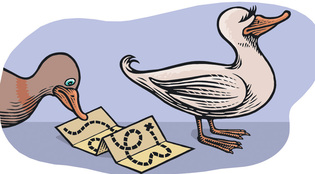 loading
loading
FindingsQuack means quack Gregory NemecView full imageA female duck may choose a mate, but his buddies won’t care. In some duck species, 40 percent of all copulations are forced upon females. Yet fewer than 5 percent of these species’ offspring are sired by undesirables. It turns out the female has a few tricks up her, well, vagina. Patricia Brennan, a research associate in ecology and evolutionary biology, was the first scientist to examine the labyrinthine reproductive anatomy of duck females. “It looks like an obstacle course,” she says. (For more on her studies, see “Birth Control for Ducks.”) In many duck species, reproductive tracts are long and corkscrew-shaped. In most bird species, the female reproductive tract is a simple tube tucked inside the bird’s cloaca, its single opening for reproduction and excretion. But in many duck species, males have developed long and usually corkscrew-shaped penises. Females, Brennan discovered, can have equally long corkscrew-shaped vaginas. “But,” Brennan says, “the organs spiral in opposite directions.” To get a better look at how these parts interact, Brennan and colleagues employed video, custom-twisted glass tubes, and randy ducks. Their findings show that in the evolutionary gender wars, a female can win where it counts: choosing who fathers most of her offspring. (The research appeared in the Proceedings of the Royal Society B: Biological Sciences.) Brennan first filmed the unfurling of the duck’s penis, normally tucked in the cloaca. She calls this process “explosive”—the organ reaches 20 centimeters in a mere third of a second—and notes, “If he manages to get in the right position, she can’t stop him from getting inside her.” Then Brennan and her colleagues studied the males’ attempts to mate with the glass tubes—stand-ins for duck vaginas. The serpentine models stopped the phalluses, and the sperm they carried, from traveling very far. “She can prevent an unwanted male from delivering the goods,” says Brennan. “But she’ll relax to make things easier for her mate.”
The comment period has expired.
|
|